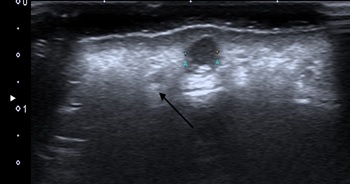High Resolution Ultrasound of Soft Tissues for Characterization of Fillers and its Complications
Keywords:
Ultrasonics, Skin diseases, Biopolymer, Hyaluronic acidAbstract
Introduction: High resolution ultrasound has proven to be a useful diagnostic method for the detection of exogenous material, its characterization and evaluation of its complications. This study is a series of cases of 60 patients collected in a period of 3 years. It is a retrospective, descriptive study. Objectives: To describe the most frequent locations of the exogenous material in the affected areas of the body. To describe the type of exogenous material most used and its ultrasound appearance. To establish the most frequent complications. Methods: High resolution ultrasound was performed by a radiologist with eight years of training in dermatological ultrasound. The studies were carried out in a Toshiba Xario 200 device with an 18 MHz lineal transductor. For the statistical analysis, measures of central tendency, description of frequencies and crossing of variables were used. Results: the average age of the patients was 55 years, 90.5% of the patients were women. The most affected area were the nasolabial folds where exogenous material was found in 85.7% of the patients. The substance most commonly found was biopolymers in 39%; liquid silicone and oil had respectively 32.5% and 15.6%. In 67.2% of the cases the patients presented physical deformity manifested as a palpable or visible mass. Conclusion: The ultrasound allowed us to identify the different types of exogenous substances, their location in the specific anatomical area and the complications related to their use, providing useful information to the attending physician and impacting the management of the patients.
Downloads
References
Ashinoff R. Overview: soft tissue augmentation. Clin Plast Surg. 2000;27:479-87.
Klein AW. Collagen and other injectables of the skin. Dermatol Clin. 2001;19:491-508.
Menis D, Castellanos González M, LLamas-Martin, Vanaclocha S. The utility of skin ultrasound for the diagnosis of complications of tissue fillers materials. Dermosifiliogr. 2014;105(8):797-8. doi: 10.1016/j.ad.2013.11.012.
Young SR, Bolton PA, Downie J. Use of high-frequency ultrasound in the assessment of injectable dermal fillers. Skin Res Technol. 2008;14(3):320-3.
Wortsman X. Sonography of cosmetic procedures. En: Dermatologic ultrasound with clinical and histologic correlation. Wortsman X. Jemec G. New York: Springer; 2013.
Wortsman X. Wortsman J. Sonographic outcomes of cosmetic procedures. AJR. 2011;197:W910-8.
Wortsman X. Common applications of dermatologic sonography. J Ultrasound Med. 2012;31:97-111.
Grippaudo FR, Mattei M, Mattei M. Utility of high-frequency ultrasound in dermal filler evaluation. Ann Plast Surg. 2011;67(5)469-73.
Giovagnorio F, Drudi FM, Valentini C, Paonessa A. Ultrasonography in follow-up of soft tissue augmentation of the face with synthetic materials: a pilot study. Acta Radiol. 2004;45(7):746-50.
Schelke LW, Van Den Elzen HJ, Erkamp PP, Neumann HA. Use of ultrasound to provide overall information on facial fillers and surrounding tissue. Dermatol Surg. 2010;36(Suppl 3):1843-51.
Salles AG, Remigio AFN, Saito OC, Camargo CP, Zacchi VB, et al. Avaliação da durabilidade de preenchimento de ácidohialurônico com ultra-som facial. Arquivos Catarinenses de Medicina. 2009;38:281-3.
Addor F, Nogueira S. Injectable polyethylene glycol gel as dermal filler: 01 year clinical and ultrasound follow-up. J Clin Exp Dermatol Res. 2016;7:2. doi: 10.4172/2155- 9554.10003312.
Chacon AH. Fillers in dermatology: from past to present. Cutis. 2015;96 (5):E17-9.
American Society of Plastic Surgeons. Plastic Surgery statistics Report [internet]. 2014 [citado 2018 dic. 15]. Disponible en: http://www.plasticsurgery.org/news/plasticsurgery- statistics/2014-statistics.html.
Bailey SH, Cohen JL, Kenkel JM. Etiology, prevention, and treatment of dermal Filler complications. Aesthet Surg J. 2011;31:110-21.
Ginat DT, Schatz CJ. Imaging features of midface injectable fillers and associated complications. AJNR Am J Neuroradiol. 2013;34(8):1488-95.
Cohen L. Understanding, avoiding, and managing dermal filler complications. Dermatol. Surg. 2008;34(Suppl 1):S92-9.
Cox SE, Adigun CG. Complications of injectable fillers and neurotoxins. Dermatol. Ther. 2011;24(6):524-36.
Rodríguez JM, Xie YL, Winthrop KL, Schafer S, Sehdev P, Solomon J, et al. Mycobacterium chelonae facial infections following injection of dermal filler. Aesthet. Surg. J. 2013;33(2):265-9.
Bray D, Hopkins C, Roberts DN. A review of dermal fillers in facial plastic surgery Curr. Opin. Otolaryngol. Head Neck Surg. 2010;18(4):295-302.
Carruthers JD, Fagien S, Rohrich RJ, Weinkle S, Carruthers A. Blindness caused by cosmetic filler injection: a review of cause and therapy. Plast. Reconstr. Surg. 2014;134(6):1197-201.
Coiffman F. Alogénosis iatrogénica: Una nueva enfermedad. Cir. Plást. Iberolatinoamericana. 2008;34(1):01-10.
Quezada Gaón N, Wortsman X. Ultrasound-guided hyaluronidase injection in cosmetic complications. J Eur Acad Dermatol Venereol. 2016;30(10):e39-e40. doi: 10.1111/ jdv. 13286.
Alfagame F. Ecografía en materiales de relleno inyectables. En: Ecografía en dermatología y dermoestética. Alfagame F, Roustan G. Buenos Aires: Ed Panamerica; 2017. pp. 131-6.
Wortsman X, Wortsman J. Polyacrylamide fillers on skin ultrasound. J Eur Acad Dermatol Veneorolg. 2012;26:660-1.
González CP. Ecografía de lesiones dermatológicas. Rev. Colomb. Radiol. 2014;25(3):4006-14.
Wortsman X. Wortsman J, Orlandi C, Cárdenas G, Sazunic I, Jemec GBE. Ultrasound detection and identification of cosmetic fillers in the skin. J Our Acad Dermatol. 2012;26:233-9.
González LF, Alviar JD, Cano H. Análisis infrarrojo del hialucorp, metacorp y silicona líquida en el marco de la alogénosis iatrogénica. Rev. Col de Cirugía Plástica y Reconstructiva. 2017;23(1):37-45.
Abduljabbara M. Basendwh M. Complications of hyaluronic acid fillers and their managements. J Dermatol Dermatol Surg. 2016;20(2):100-6.
Winkler A, Meyers A. Injection facial fillers [internet]. 2018 [citado 2018 dic. 15]. Disponible en: emedicine.medscape.com/article/1574158-overview.
Micheels P, Besse S, Sarazin D, Quinodos P, Badwi E, Safa M, Vandeputte J. Ultrasound and histologic examination after subcutaneous injection of two volumizing hyaluronic acid fillers: A preliminary study. Plast Reconstr Surg Glob Open. 2017;5(2): e1222.
Kohn JC, Goh AS, Lin JL, et al. Dynamic high-resolution ultrasound in vivo imaging of hyaluronic acid filler injection. Dermatol Surg. 2013;39:1630-6.
Micheel P, Besse S, Sarazin D, Vicent A, Portnova N, Safa M. Quantifying depth of injection of hyaluronic acid in the dermis: Data from clinical, laboratory, and ultrasound settings. J Drugs Dermatol. 2016;15(4):483-90.
Lemperle G, Gauthier-Hazan N. Foreign body granulomas after all injectable dermal fillers: part 2. Treatment options. Plast Reconstr. Surg. 2009;123(6):1864-73.
Tejero García P, Ríos de los Ríos L, Sánchez Hidalgo A. Efectos adversos tardíos del ácido hialurónico: Revisión de la evidencia y la experiencia clínica. Medicina Estética. 2011(27):31-6.
Vedamurthy M, Vedamurthy A. Dermal fillers: Tips to achieve successful outcomes. J Cutan Aesthet Surg. 2008;1(2):64-7.
Haneke E. Managing complications of fillers: Rare and not-so-rare. J. Cutan Aesthet Surg. 2015;8(4):198-210. doi: 10.4103/0974-2077.172191.
Worstman X. Sonography of skin emergency. J Ultrasound Med. 2017;36(9):1905-14.
Worstman X. Identification and complications of cosmetic filler: Sonography first. J Ultrasound Med. 2015;34(7):1163-72. doi: 10.7863/ultra.34.7.1163.
Duffy DM. Silicone for soft tissue augmentation. Dermatol Surg. 2005;31(11 Pt 2):1530-41.
Jacinto S. Ten-year experience using injectable silicone oil for soft tissue augmentation in the Philippines. Dermatol Surg. 2005;31(11 Pt 2):1550-4; discussion 1554.

Downloads
Published
How to Cite
Issue
Section
License

This work is licensed under a Creative Commons Attribution-NonCommercial-ShareAlike 4.0 International License.
La Revista Colombiana de Radiología es de acceso abierto y todos sus artículos se encuentran libre y completamente disponibles en línea para todo público sin costo alguno.
Los derechos patrimoniales de autor de los textos y de las imágenes del artículo como han sido transferidos pertenecen a la Asociación Colombiana de Radiología (ACR). Por tanto para su reproducción es necesario solicitar permisos y se debe hacer referencia al artículo de la Revista Colombiana de Radiología en las presentaciones o artículos nuevos donde se incluyan.






